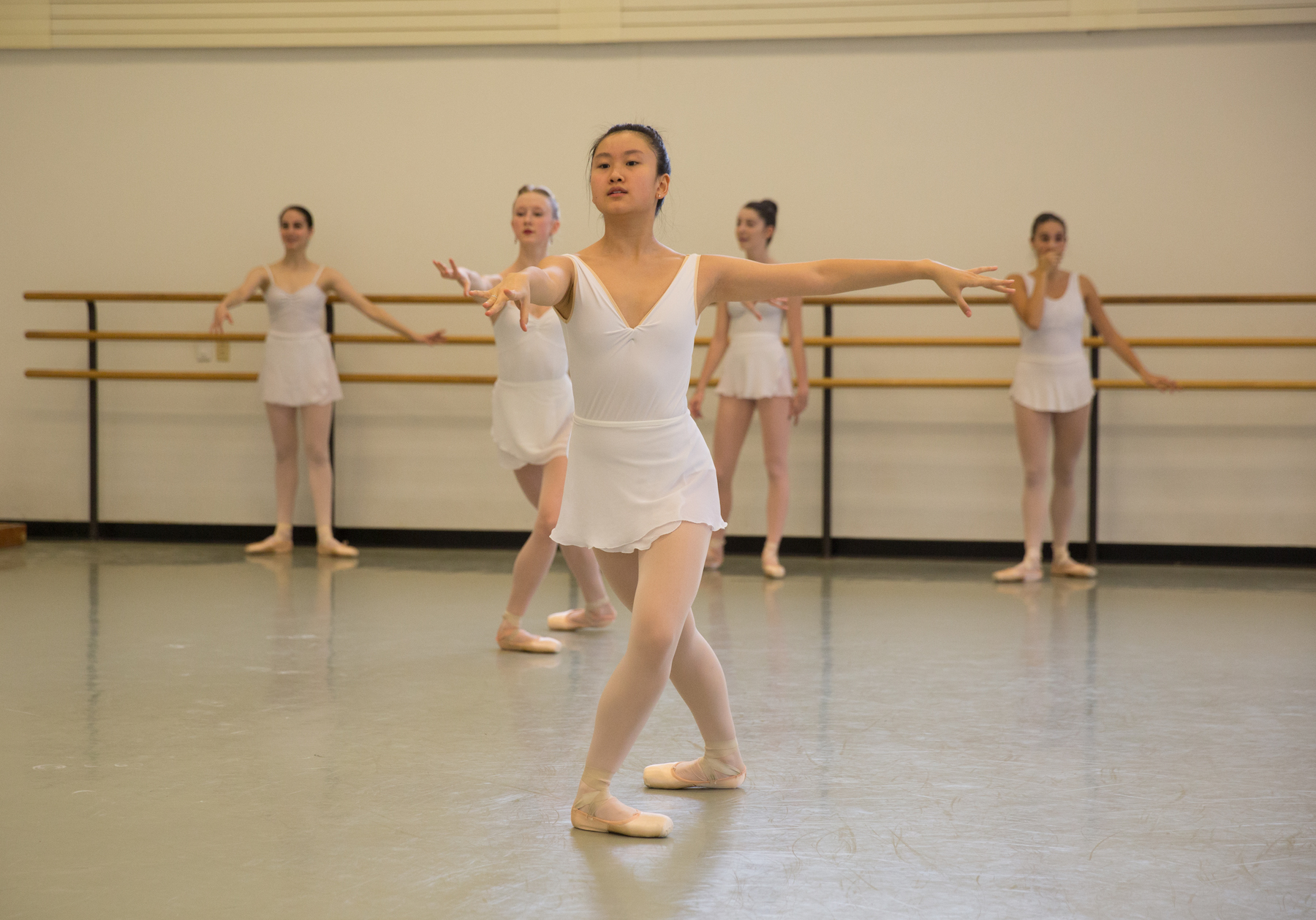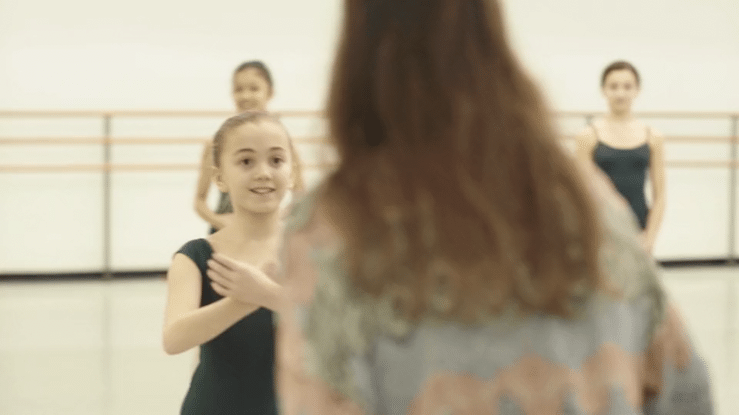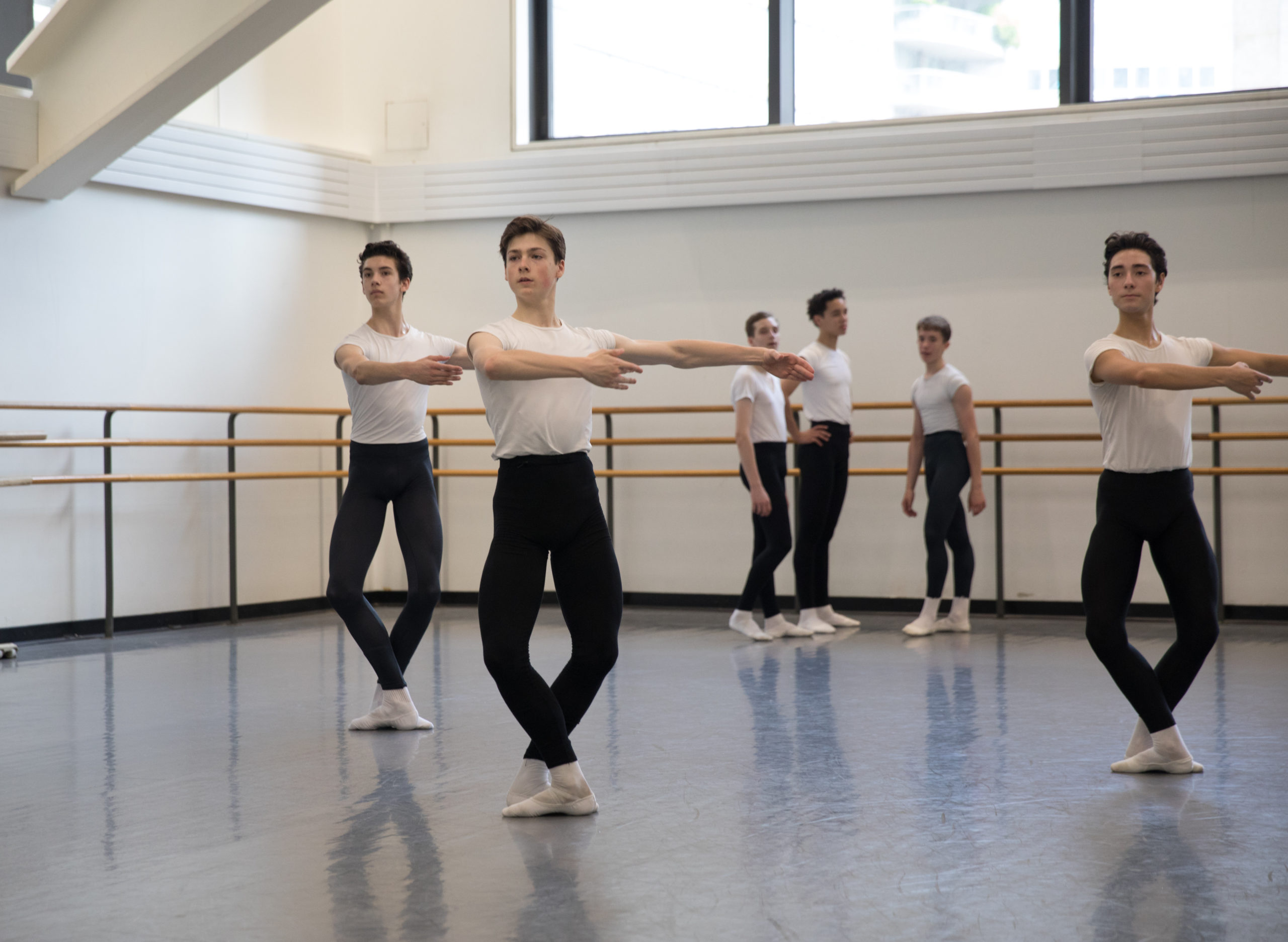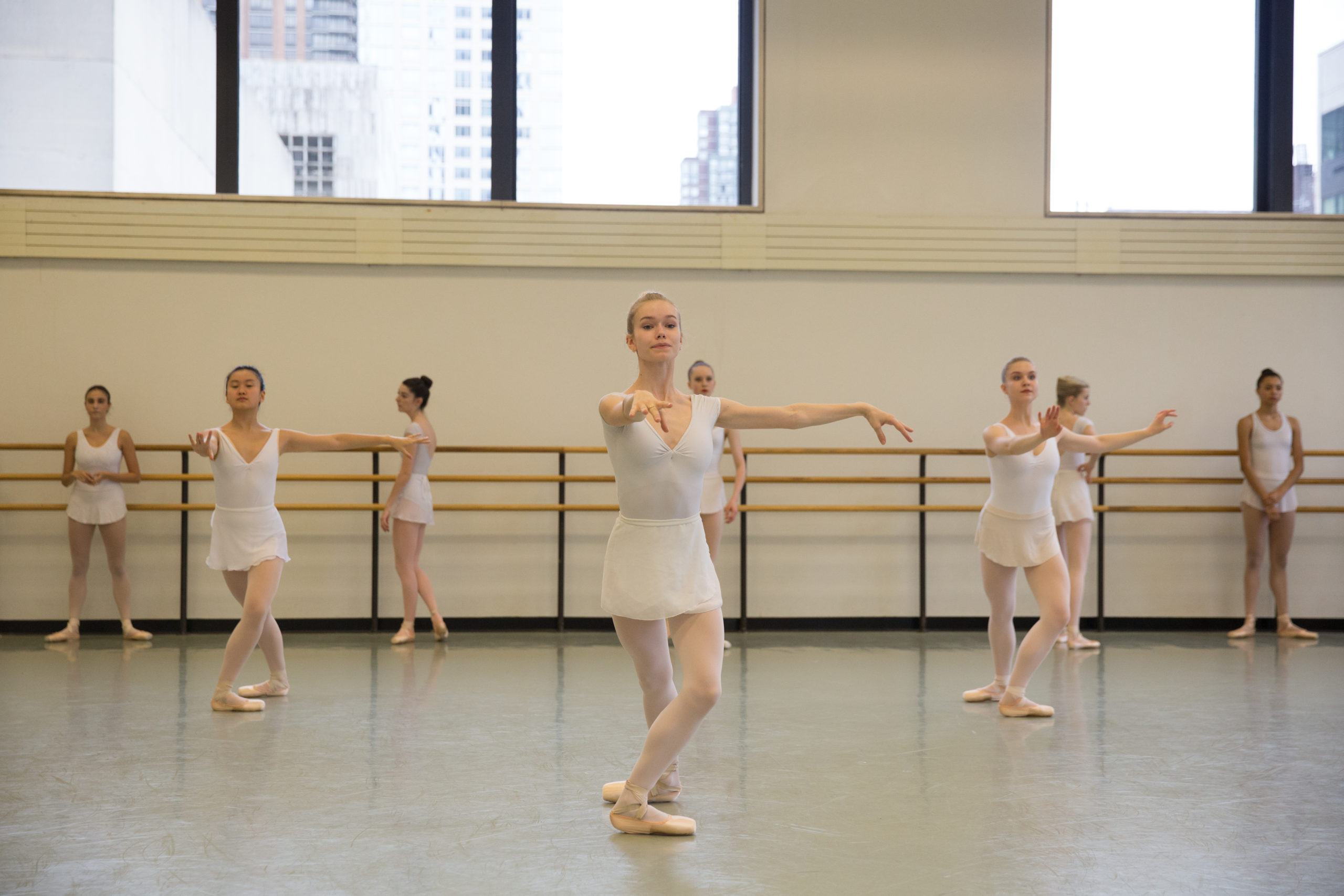Turning in ballet can be at once thrilling and daunting for a dancer. Likewise watching a dancer execute pirouettes with control, precision, technique and grace is an incredible sight for an audience to behold. This excerpt of Suki Schorer on Balanchine Technique covers certain aspects of the technique that are common to all the turns – the position of the working foot, arms, and spotting. However, Ms. Schorer goes on to break down details of several specific kinds of turns on pointe in the book – including pirouettes from fifth and fourth positions, piqué turns, and chaîné turns – and we encourage readers to consult the full text for more information on the proper way to execute those turns and more.

Position of the Working Foot While Turning
While turning, the pointe of the working foot is usually placed in front and on the midline of the supporting leg at the knee or just below it. The toe should not “overcross” that is, go beyond the supporting leg. Also, the toe should not be pressed against the supporting leg. Balanchine liked to say that we should be able to slip that piece of paper between the little toe and the supporting leg. Only if this is possible can the dancer be sure she is maintaining the turnout with the muscles of the working leg and hips, rather than forcing the knee back by actively pushing the working foot against the supporting leg. Maintaining the turnout in the correct way strengthens the pirouette and gives life to the position.
Sometimes Mr. B liked to have us place the pointe of the working foot behind the supporting knee. This helped the dancer to hold her knee back, keeping the turnout in passé. He liked to add variety. He sometimes had us place the working foot at lower levels along the center line of the supporting leg. Occasionally he asked us to wrap the foot in sur le cou-de-pied, another position that helps the dancer hold the knee back. He was always trying different ways to help us maintain the turnout.
These variations on the standard position gave us an adaptability that was also useful in choreography and, on occasion, in supported turns, when a more compact position was sometimes necessary to avoid hitting our partner with our knee. We could achieve this compactness by placing the working pointe slightly below the supporting knee while turning, although at the finish we might raise it to the knee. Even in slow, unsupported turns we often raised our working pointe at the end of the turn to give it added energy and life, sustaining it before ending in fifth or fourth, or lifting the working leg to an extended line for a pose such as arabesque in plié.

Arms in Turning
The arms and hands should help the turn, but they should not be exaggerated. Remember Mr. B’s pun, “Hands shouldn’t be a handicap.” On pointe there is very little friction with the floor, so women need only a minimum of force to turn. The last thing Balanchine wanted was arms that looked as if they were flailing at unseen opponents.
“Too much force! he would say if one of the women used her arms too aggressively, “enough for a hundred turns. We need two beautiful turns, right and left.”
Men definitely need more than two turns, and their turns also require more force because there is more friction on demi-pointe. Therefore they need to learn to get much of the impetus from their legs through the power in the plié and the push off from the floor of the working leg and foot, as well as from the coordination of the arms and the torso. They also cannot become dependent on throwing their arms around.

Balanchine was very particular about the look of our arms before the turns. In our big fourth position lunge, he usually wanted beautifully stretched third arabesque arms. Sometimes, to get us to really extend our arms, Balanchine would say, “What do you like? Ice cream, diamonds, or money?” To a dancer who chose money, he would say, “Here’s a million dollars!” as he held the imaginary bait in front of her leading hand, “Take it! Take it!” He used this ploy not only to lengthen the line but also to remind us to bring the face forward and lengthen the neck, to give life to our fingers and focus to our eyes, thus imparting dynamic energy to the whole pose.
Balanchine was very specific about the way we used our arms during various turns. Just before the plié starting a turn en dehors from fifth or en dedans from fourth or fifth, we usually had one arm rounded in first position and the other to the side in second – standard pirouette arms. During the plié the front arm opened forward and toward the side. This helps the dancer keep her weight forward as well as giving her some impetus for the turn. Then, as we turned, both arms closed to a rounded, slightly overcrossed and somewhat lower than usual first position, a relatively tight first position that is similar to a gentle squeeze – a little like hugging yourself.

“Leave nothing hanging out, nothing extra,” Violette Verdy liked to say, referring to elbows jutting out as well as to hips hanging back. The arms should stay roughly on the same plane; they don’t lift higher than second or lower down to waist level to close. This is especially important in consecutive turns from fifth. The position is relatively compact, but there is still space and air between the arms and the body…
The impetus of the turn comes mostly from the legs and back foot and somewhat from the back arm, which starts slightly behind à la seconde and then moves around through second and then toward the chest, and closes over the other arm. From the third arabesque line, the upper arms pull in and down from the sides of the back (under the armpits). The two arms are coordinated, which also gives some impetus, moving at the same time to the final position, which is elbows down, forearms crossed, and palms facing in. They are presented gracefully and supported; there is air and space between them and also between the arms and the chest; they are not held tight and flat against the chest. The dancer can feel that she brings her chest up and forward to meet her crossing arms instead of feeling that her arms coming in almost push her backward. She also needs to feel her torso, neck and head lengthen up as her shoulders pull down. Men turn with more rounded arms – for example, rounded arms in an overlapped first position.
…The key for the dancer in turning is that she brings everything in toward her center line and over her pointe. Her arms are in, but not so close to her torso that there is no air, her hips are up, the supporting hip over the supporting leg, her chest is lifted, her neck and head are erect and centered.
Spotting
In general we used the technique for spotting used by dancers trained elsewhere: We focused our eyes on one fixed point and remained focused on it as we began to turn. When we could no longer see it, we instantly whipped our head around so the same point came into view again. Mr. B did not want to see a “slow spot,” momentarily leaving the back of the head to the audience. I tell the class, “I don’t want to see your bun, I want to see your eyes!”
He differed from other teachers and choreographers in that he wanted us to spot front in en dehors and in en dedans turns, no matter where we were facing at the start of the turn. This was true not only of pirouettes but also of traveling turns such as piqués, step-ups, assemblés en tournant, and chaînés, whether performed on the diagonal or straight to the side. He did not want the side of the head left facing the audience. Balanchine would joke, “Don’t look sideways! Look front. Your mother wants to see your pretty face”… Spotting front reveals the dancer’s entire front: her face, her turnout, and her open chest.
In spotting, teachers and dancers generally focus awareness on the very fast turn to the spot of the head. My colleague Stanley Williams used to say, “Stay front!” meaning the dancer should not concentrate her energy on spinning or twisting around….

When a dancer’s focus is not front, she will often make the mistake of changing her focus to the front before starting the turn. If, for example, she is in fourt position croisé in a third arabesque line for an en dehors pirouette, the tendency is to turn the head to look front as she starts the turn. Mr. B wanted, in contrast, a dynamic lunging fourth with a clear focus over and beyond the leading hand. As the dancer starts the en dehors turn, she leaves her head there and then spots front for the first and each succeeding revolution. Mr. B also gave en dehors turns from fourth position effacé, which are rarely given. In this case, the dancer comes front as she starts the turn and spots front on each succeeding revolution. When the dancer turns en dedans from fourth croisé or effacé, she usually has her neck bent and her head slanted so that her focus is al- ready front, and no change is needed to spot front.
Spotting helps the dancer control the speed of the turn and the number of rotations as well as preventing dizziness. If we were spotting slowly on faster turns or rushing the spot in slower turns, Balanchine would often stop the class and have us count out loud in a steady tempo. For a double turn we would count “one-two-land.” The “one” was the first spot, the “two” was the second spot, and “land” was our finish. Counting out loud had two effects: It released the tension in the neck, allowing us to spot easily, and it gave us the tempo of the turn. The counting works best, however, if you say the words out loud and with real conviction. I tell my classes to use the tone they would to command a playful dog to sit, “SIT.”
…The one turn we did not spot was the arabesque turn. Mr. B wanted us to assume the pose and simply turn it. Attitude turns, in contrast, were treated
as a kind of pirouette and were done with spotting.
(Schorer, 1999, p.261-267)
Schorer, S., Lee, C. R., & Rosegg, C. (1999). Suki Schorer on Balanchine Technique. A.A. Knopf.







